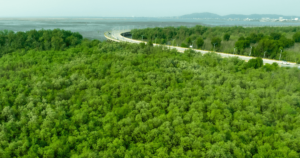Bengal Energy Ltd. (TSX: BNG) is on target to produce oil and gas from three different projects in Australia by the end of 2022.
The recent private placement in which Canadian and Australian investors acquired 52.3 million common shares for approximately CAD4.2 million will enable the company to embark on an organic growth programme that is set to quadruple its production over the next two years. The group of investors was led by insiders, both Directors and Senior Executives, and their friends and families.
In addition to the Cuisinier Oilfield, in the heart of the Cooper Basin – where Bengal has been pumping out more than 200 barrels of oil per day in a joint venture with Santos – the company has been looking to bring new life into its 100% owned Wareena and Caracal projects, in onshore Queensland. However, reviving and recommissioning the Wareena wells, and establishing the necessary infrastructure at Wareena and Caracal-1 (in the Tookoonooka block) has, up until now, been slowed down by a lack of funding.
Bengal needed close to CAD2.8 million for the restart of shut-in producer wells and re-commissioning of pipeline infrastructure at the Wareena block and up to CAD2.2-million to stimulate the Caracal-1 well, and to establish storage and load-out infrastructure at the company’s 100% owned and operated ATP Tookoonooka block. Bengal is funding these projects from the proceeds of the financing, and from its existing cash and positive cash flows.
With oil and gas prices racing towards record highs on the back of a variety of reasons including the Russian invasion in the Ukraine, the market conditions are favourable for Bengal to complete its capital programme and to restart production at Wareena and Caracal-1.

Bengal hits the ground running
As a junior exploration and development company, Bengal Energy, unlike the large oil majors, is agile enough to develop and bring both these projects into production in double quick time. Bengal’s early production system is innovative and allows the company to commercialise its production quickly. In the world of oil and gas, this is a distinct advantage. The company’s unique ability to generate a good return within months and its solid balance sheet and positive cash flows enable Bengal to add value in a way few other oil and gas companies can do in the early stages of production.
Wareena produced natural gas in the past, and there is an existing pipeline, although it needs refurbishment. The absence of gas pipelines is the major constraint in developing new gas projects and often causes significant delays in both greenfield and brownfield developments. With the necessary funding in place, Bengal will be able to commission the refurbishment work in March and start producing from the two historic wells as soon as October this year.
Bengal discovered oil at Caracal-1 about eight years ago. Although there is enough oil to produce at a consistent rate, the rock has a low permeability and needs stimulation to allow the oil to flow. The oil can be shipped by road tankers for about 60km to a local refinery. Bengal expects Caracal to come into production as soon as May 2022.
Once Bengal has completed these workovers and tied them in, and the wells start producing oil and gas, the resource will turn into reserves. Once turned on, it is possible that both these projects with a relatively small capital exposure could turn into something much bigger, and that is the upside. If Caracal-1, for example, is successful, Bengal will immediately have a drilling target to follow up on, requiring some seismic definition around this prospect. If successful, Bengal could drill a second well and at that point have bigger reserves and can start building a more extensive field development plan. Then they will have a sense of how many wells it takes to drill out and properly exploit this pool and put a capital development plan behind it.
More upside to Bengal
The real upside for Bengal Energy is that in addition to these three projects, there are another three oil and gas deposits (Ghina, Ramses and Karnak) that look enticing. Karnak is a natural gas discovery while Ramses has natural gas and oil. Although oil at Ramses was discovered and tested in a shallower zone, there is enough evidence to prove that the area between Karnak and Ramses is highly prospective in the natural gas horizon, which is fascinating. If this is the case, it speaks to a much larger volume that encompasses both fields and additional prospects.
Bengal has a well-balanced and diversified oil and gas portfolio with a lot of upside and low geopolitical risk. The hydrocarbon space is notoriously cyclical and will never be a game for the faint- hearted. However, to de-risk, placing your bets in a top-notch international jurisdiction like Australia (which is way up there with the leaders of the pack when it comes to oil and gas production) with a significant near-term growth upside, is a conservative but nevertheless, extremely safe move.
Innovative and technology focussed oil and gas companies like Bengal sit pretty in a challenging and risky world. Its assets in the prolific Cooper Basin in Queensland hosts a good spread of quality oil and gas deposits with enormous upside potential to drill out a few world-class wells.
Moreover, Bengal’s innovative technology, the Roadrunner pump, makes it easy to roam its lease areas and limit the company’s environmental impact. The trailer-based beam pump, part of Bengal’s Early Oil Production System (EOPS), works in tandem with several tanks to accelerate production and establish design parameters for further capital investment. Bengal expects this approach to lower the risks of this cost-effective development of reserves by rightsizing facilities.
Bengal looks robust
In a world where oil and gas projects continuously face relentless headwinds, Bengal Energy appears to be one of the more robust outfits. The company has been active in the oil and gas space for more than 15 years, has a debt free balance sheet and over CAD6 million cash in the pocket. Its strong mix of JV, 100%-owned cash generative and high growth exploration assets make it the ideal junior exploration and production outfit in an uncertain and hostile market. It is these companies that one looks for when you have an appetite for risk.
Bengal has benefited from positive cash flows from its Cuisinier production that supports its G&A and development activities. Recent increases in crude oil prices will materially increase cash flows allowing Bengal to accelerate its development and exploration activities in addition to the current Wareena and Caracal projects. There is no doubt that Bengal is destined to become a significant independent player in the Cooper Basin, which has become a major energy supplier in the international oil and gas space.
With the gas prices heading north, and an imminent supply crunch looming, the Cooper Basin is attracting increasing attention from around the globe. The Cooper Basin was discovered in the 1960’s and hosts Australia’s largest onshore oil field, the Jackson oil field, which was discovered in 1981. More than 1800 petroleum wells have been drilled in the Cooper Basin.
Overall, there are close to 160 gas fields and 75 oil fields in production containing 630 producing gas wells and about 340 producing oil wells. There are many small, listed companies drilling the Basin. They include, amongst others, Bass Oil, Bengal Energy, Leigh Creek Energy and Bridgeport.
The largest producer and infrastructure owner in the Cooper Basin is Bengal Energy’s JV partner Santos QNT Pty Ltd with its main production facility at Moomba in South Australia at the head of the Moomba Adelaide Pipeline System.
Overall, Bengal Energy has a clean balance sheet, strong insider support and buying. The company is embarking on a massive growth phase, which could see significant share value growth.
In current times of unprecedented uncertainty, it is important to get exposure to commodities. In this respect, Bengal Energy is an excellent oil and gas price sweet spot, operating in an extremely low-risk geopolitical jurisdiction, and has got momentum behind it.






